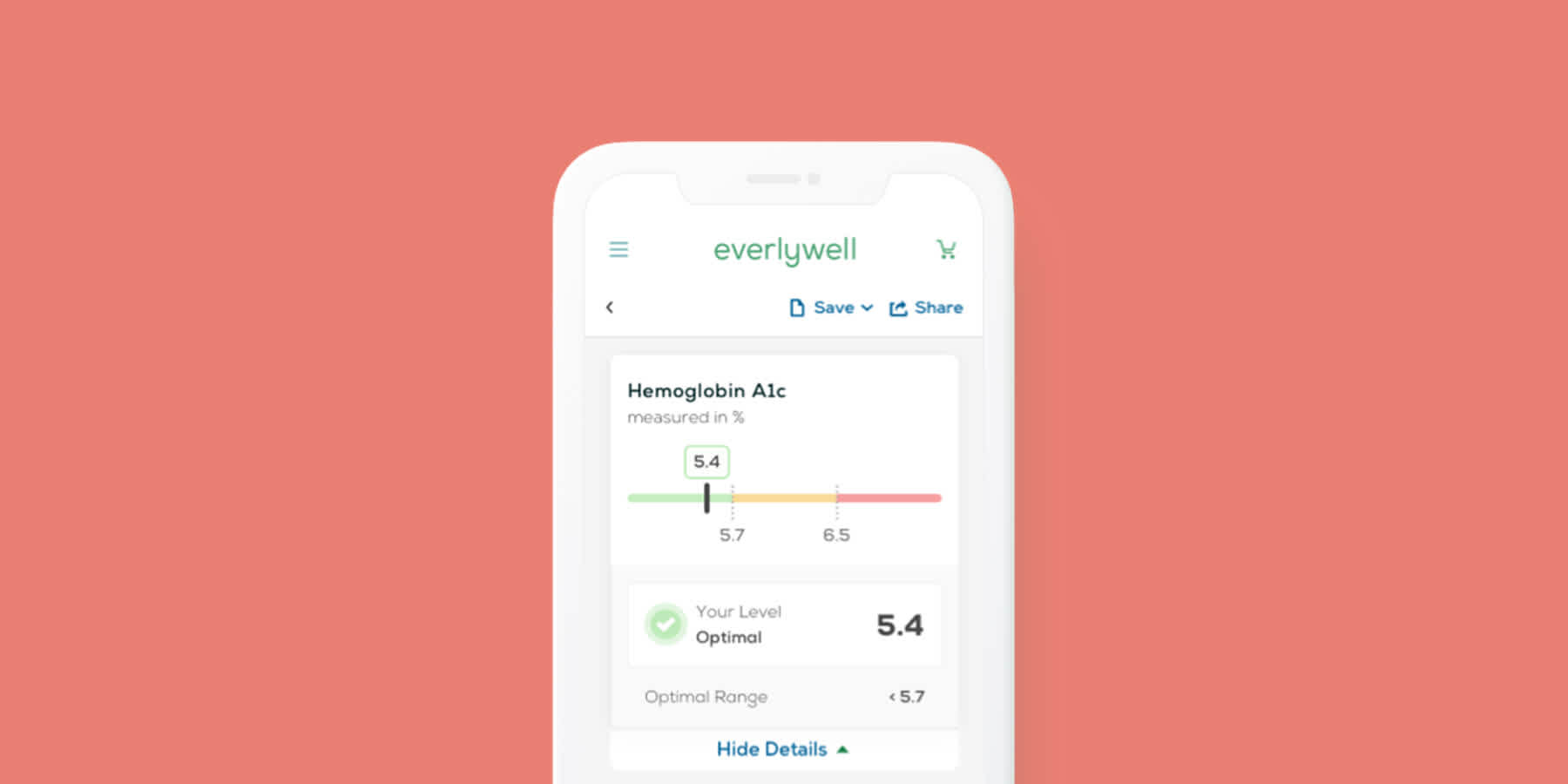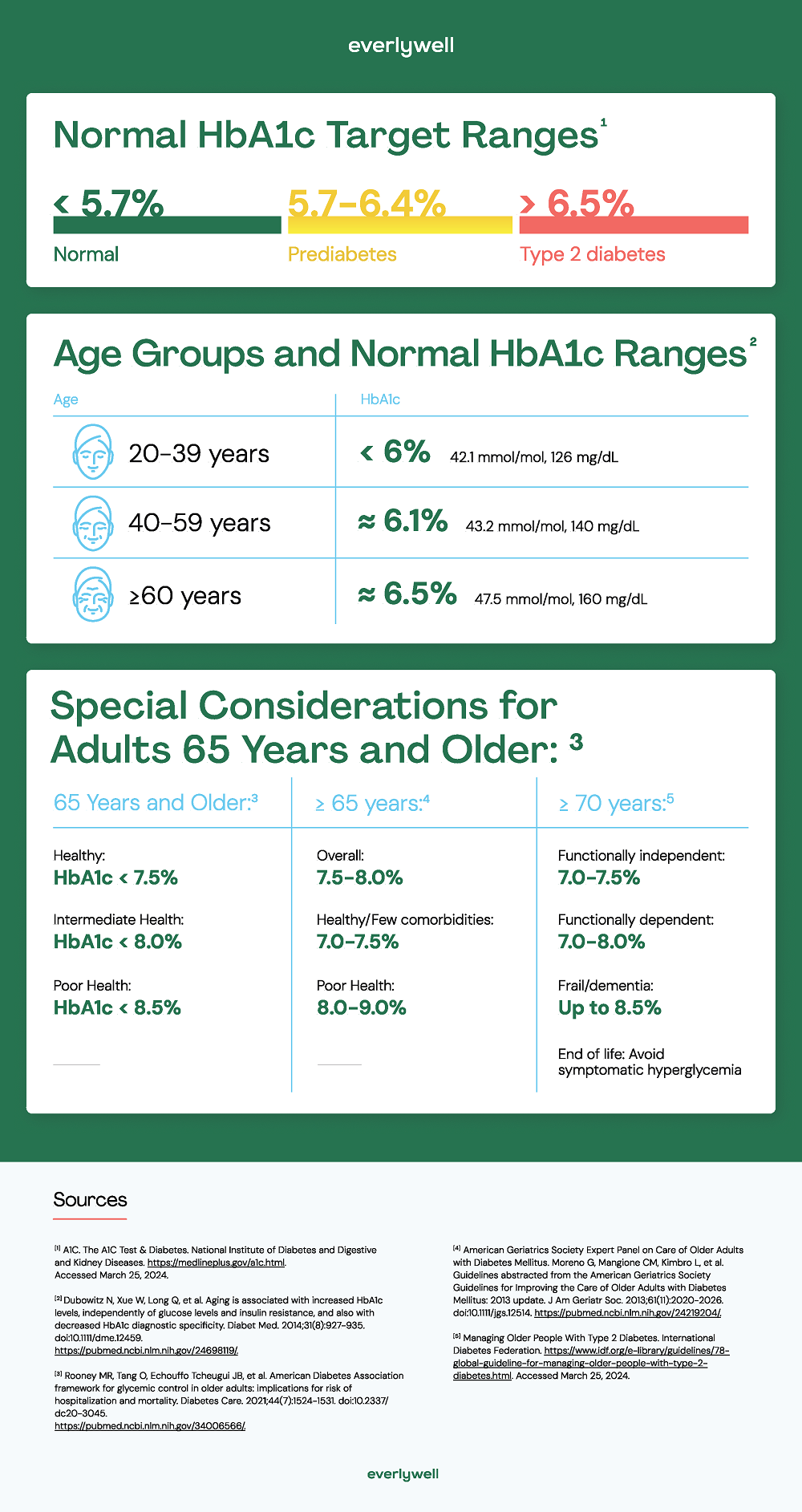
What is normal HbA1c by age?
Updated on November 30, 2023.
Written on January 3, 2023 by Amy Harris, MS, RN, CNM. To give you technically accurate, evidence-based information, content published on the Everlywell blog is reviewed by credentialed professionals with expertise in medical and bioscience fields.
Table of contents
- What Is the HbA1c Test?
- What Are Normal HbA1c Ranges?
- Why do normal HbA1c ranges vary by age?
- Controversy over updated HbA1c ranges for adults 65 years and older
- At what age should you check your HbA1C?
- Find out whether your HbA1c is normal for your age
- Related content
HbA1c, or hemoglobin A1c, is a “powerhouse” of a diagnostic test, according to the American Diabetes Association [1]. With more than 100 million U.S. adults living with diabetes and prediabetes, a powerhouse is just what the doctor ordered [2]. With a single finger prick, the HbA1c test (also known as the hemoglobin A1c test) can screen for prediabetes, diagnose diabetes, and manage your diabetes treatment plan over time [1]. However, it turns out that factors such as your age, race, and other medical conditions, such as your pregnancy status, can all impact your HbA1c levels [3]. Learn more about normal hemoglobin A1c by age to stay healthier and live longer (and consider an at-home HbA1c test).
What Is the HbA1c Test?
The HbA1c blood test measures how much blood glucose (sugar) is attached to your hemoglobin. A1C stands for glycated hemoglobin, a crucial marker in diabetes management. Glycated hemoglobin is the medical term describing how your red blood cells (containing a protein called hemoglobin) become loaded up with glucose. As glucose circulates in your bloodstream (such as after eating), it sticks to the hemoglobin in your red blood cells. Sugar is sticky, and in your body, it stays attached to your hemoglobin for up to 3 months (the average lifespan of your red blood cells).
The higher the sugar levels are in your bloodstream, the more red blood cells are covered with sugar molecules. The HbA1c test measures the percentage of the hemoglobin in your red blood cells covered in sugar. So the higher your average blood sugar level for the past three months, the higher the number of “sugary” red blood cells, and the higher your hemoglobin A1c test result.
Healthcare providers use HbA1c alone or in combination with other diabetes tests to diagnose prediabetes or type 2 diabetes. Hemoglobin A1c tests aren’t as effective for identifying more recent spikes in blood sugar, so they’re not commonly used to diagnose type 1 diabetes [4]. Blood sugar tests provide quicker results, but that's not to say A1c test results have no value in type 1 diabetes management [5].
What Are Normal HbA1c Ranges?

For you sports statheads out there, the A1C test is like a baseball player's season average — it tells you about a player's overall success. However, your A1C does not tell you about your blood sugar for just one day, just like a player’s single-game batting record won’t tell you if they are a good player. For adults, healthcare providers use the following HbA1c target ranges in diagnosing diabetes [6]:
- A normal A1C level is below 5.7%
- Prediabetes is between 5.7 to 6.4%
- Type 2 diabetes is above 6.5%
- The goal for most adults with diabetes is an A1C that is less than 7%
But, just as a younger, stronger baseball player may have a better season average than an 80-year-old grandfather with poor eyesight, HbA1cs vary greatly with age.
Why do normal HbA1c ranges vary by age?
iabetes researchers and doctors are still not in agreement over why age makes it harder for people to maintain lower HbA1cs (or better overall diabetic and blood sugar control) [7]. More than likely, there are multiple factors, and as they say, “It's complicated.”
Regarding the numbers, there's no one-size-fits-all target for HgA1c. A1C target levels vary by each person's age, race, and other factors, and your target may be different from someone else's [3,7].
As you get older, your hemoglobin A1c level increases [7]. This increase happens regardless of whether or not you have diabetes [7].
Age-Related A1C increase with non-diabetes [7]
| Age in Years | HbA1c | Mmol | Mg/dL |
| 20-39 | 6% | 42.1 | 126 |
| 40-59 | 6.1% | 43.2 | 140 |
| ≥60 years | 6.5% | 47.5 | 160 |
Controversy over updated HbA1c ranges for adults 65 years and older
There is an ongoing debate among healthcare providers and diabetes researchers regarding how best to manage older people with diabetes. Adults aged 65 and older have many complex health conditions and represent a diverse patient population to which a single hemoglobin A1c target guideline does not always apply [9].
The American Diabetes Association, the American Geriatrics Society, and the International Diabetes Federation all adjusted their target HbA1c ranges for adults older than 65 and then further broke down target ranges by how healthy that senior is. They have increased their HbA1c target ranges up to 8.5 or even 9 for adult seniors greater than 65 years of age.
American diabetes association (ADA) guidelines for adults age 65 or older [10]
| Health status | HbA1c |
| Healthy | <7.5% |
| Intermediate | <8.0% |
| Poor | <8.5% |
American geriatrics society guidelines for adults ≥ 65 years [11]
| Health Category | HbA1c |
| Overall | 7.5-8.0% |
| Healthy/Few comorbidities | 7.0-7.5% |
| Poor health | 8.0-9.0% |
International diabetes federation guidelines for adults ≥ 70 years [12]
| Health Category | HbA1c |
| Functionally independent | 7.0-7.5% |
| Functionally dependent | 7.0-8.0% |
| Frail/dementia | Up to 8.5% |
| End of life | Avoid symptomatic hyperglycemia |
In contrast, neither the American Association of Clinical Endocrinologists (AACE) nor the European Association for the Study of Diabetes has made age-specific adjustments for target hemoglobin A1c level based on age or health status.
There are several reasons behind the change advocated by the American Diabetes Association, American Geriatrics Society, and the International Diabetes Foundation. First, maintaining an HbA1c value of 8% or 9% is much easier than achieving less than 7%. Maintaining less than 7% requires strict glycemic control, often with more potent medications.
The more medicine administered, especially in the elderly or otherwise sick people, the greater the risk of low blood sugar episodes (hypoglycemia). If severe, hypoglycemia in the elderly can lead to a change in mental status, seizures or loss of consciousness, heart problems, falls leading to fractures, and in some cases, death [10]. Tighter glycemic control (lower HgA1c levels) may come at a higher cost for older patients.
Additionally, older adults have higher rates of unidentified cognitive impairment and dementia, making it harder to follow strict diabetic treatment plans with glucose monitoring and frequent insulin dose adjustment. Older adults with diabetes also have a greater risk of hypoglycemia than younger adults [10].
All clinical guidelines and research institutions do, however, agree that the management of diabetes, especially in older patients, needs to be personalized [9-12]. Therefore, frequently monitoring your HbA1c, either with the Everlywell at-home HbA1c test or with continuous glucose monitoring, is the best way to know how under control your diabetes actually is. In the meantime, more studies need to be done to understand the healthiest HBA1c ranges for the ever-growing number of seniors with diabetes.
At what age should you check your HbA1C?
The CDC recommends getting a baseline A1C test if you’re an adult over age 45 or are under 45, are overweight, and have one or more risk factors for prediabetes or type 2 diabetes [13]. You are at risk for diabetes if you [13]:
- Have prediabetes
- Are overweight
- Are 45 years or older
- Have a parent, brother, or sister with type 2 diabetes
- Are physically active less than three times a week
- Have ever had gestational diabetes (diabetes during pregnancy) or given birth to a baby who weighed over 9 pounds
- Are an African American, Hispanic or Latino, American Indian, or Alaska Native; some Pacific Islanders and Asian American people are also at higher risk
- Have non-alcoholic fatty liver disease
Find out whether your HbA1c level is normal for your age
Part of your wellness journey may be learning more about your risk for heart disease or diabetes. Maybe you have family members living with diabetes and are worried about your own risk. Perhaps you want to measure the impact of changes you made in your diet to lower your HbA1c. Everlywell can help you determine your metabolic wellness, using HbA1C. With our simple, quick, and convenient at-home HbA1c blood test, you can have your answers sooner rather than later.
We know that higher A1C levels are linked to more diabetes complications such as coronary heart disease and stroke [1,2]. HbA1c is the test of choice for diagnosing prediabetes and diabetes, monitoring, and managing diabetes. Knowing your HbA1c value will help you be better informed for your next healthcare appointment – more prepared to discuss your personalized diabetes care, prevention or treatment plan.
Related content
What are the warning signs of prediabetes?
References
- HbA1c. American Diabetes Association. URL. Updated 2022. Accessed December 22, 2022.
- Diabetes and Prediabetes. CDC. URL. Updated September 2, 2022. Accessed December 22, 2022.
- All About Your A1C. CDC. URL. Updated September 30, 2022. Accessed December 22, 2022.
- Butler A E, Misselbrook D. Distinguishing between type 1 and type 2 diabetes. BMJ 2020; 370 :m2998 doi:10.1136/bmj.m2998. URL. Accessed Nov 18, 2023.
- Ehehalt S, Gauger N, Blumenstock G, Feldhahn L, Scheffner T, Schweizer R, Neu A; DIARY-Group Baden-Wuerttemberg. Hemoglobin A1c is a reliable criterion for diagnosing type 1 diabetes in childhood and adolescence. Pediatr Diabetes. 2010 Nov;11(7):446-9. doi: 10.1111/j.1399-5448.2009.00633.x. PMID: 20149124. URL. Accessed Nov 18, 2023.
- A1C. MedlinePlus. URL. Updated December 22, 2015. Accessed December 22, 2022.
- Dubowitz N, Xue W, Long Q, et al. Aging is associated with increased HbA1c levels, independently of glucose levels and insulin resistance, and also with decreased HbA1c diagnostic specificity. Diabet Med. 2014;31(8):927-935. doi:10.1111/dme.12459. URL.
- Pani LN, Korenda L, Meigs JB, and Driver C et al. Effect of aging on A1C levels in individuals without diabetes: evidence from the Framingham Offspring Study and the National Health and Nutrition Examination Survey 2001–2004. Diabetes Care 2008;31(10):1991–1996. https://doi.org/10.2337/dc08-0577. URL.
- Monami M, Vitale V, Lamanna C, et al. HbA1c levels and all-cause mortality in type 2 diabetic patients: epidemiological evidence of the need for personalised therapeutic targets. Nutr Metab Cardiovasc Dis. 2013;23(4):300-306. doi:10.1016/j.numecd.2012.01.003. URL.
- Rooney MR, Tang O, Echouffo Tcheugui JB, et al. American Diabetes Association framework for glycemic control in older adults: implications for risk of hospitalization and mortality. Diabetes Care. 2021;44(7):1524-1531. doi:10.2337/dc20-3045. URL.
- American Geriatrics Society Expert Panel on Care of Older Adults with Diabetes Mellitus. Moreno G, Mangione CM, Kimbro L, et al. Guidelines abstracted from the American Geriatrics Society Guidelines for Improving the Care of Older Adults with Diabetes Mellitus: 2013 update. J Am Geriatr Soc. 2013;61(11):2020-2026. doi:10.1111/jgs.12514. URL.
- Managing Older People With Type 2 Diabetes. International Diabetes Federation. URL. Updated March 5, 2017. Accessed December 22, 2022.
- Diabetes Risk Factors. CDC. URL. Updated April 5, 2022. Accessed December 22, 2022.
